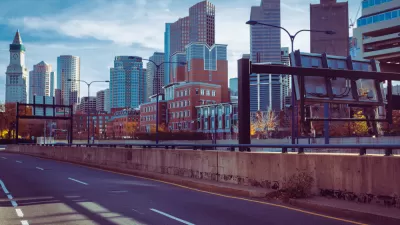In Boston, the MBTA and city planners are weighing the benefits and drawbacks of creating transit-oriented development along a major traffic corridor.
"Can a development that adds scores of cars into an already congested area be 'smart growth?'
That is the question looming over a plan to add 700 units of housing and other buildings in a tight configuration around the Forest Hills rail and bus station in Jamaica Plain.
The Forest Hills project is the largest so-called transit-oriented development yet undertaken by the MBTA in the Boston area. Such smart-growth projects are densely packed, mixed-use complexes built atop or near transit stations - whether suburban commuter rail stops or city MBTA stations - and promoted as an antidote to sprawl, congestion, and other attendant ills of the automobile age."
Yet outside its identity as a transit hub, Forest Hills is also a major chokepoint for traffic crossing the city in multiple directions, as well for commuters who drive to the station. Congestion on the two constricted main roads is a given at many times of the week. Traffic studies conducted as part of the planning process show that during the morning rush hour, more than 1,200 vehicles pass the station on Hyde Park Avenue heading toward Boston - about the same volume of traffic on Beacon Street as it approaches Kenmore Square.
Now add to that not just hundreds of new residents, but office workers at new commercial properties within the development, as well as shoppers drawn by new retail offerings, and there is a danger the Forest Hills development will make congestion worse.
"This is the most complicated aspect of this," said John Dalzell, project manager of the Forest Hills project for the Boston Redevelopment Authority, which spearheaded the planning process."
Thanks to Reconnecting America
FULL STORY: Question of congestion

Depopulation Patterns Get Weird
A recent ranking of “declining” cities heavily features some of the most expensive cities in the country — including New York City and a half-dozen in the San Francisco Bay Area.

California Exodus: Population Drops Below 39 Million
Never mind the 40 million that demographers predicted the Golden State would reach by 2018. The state's population dipped below 39 million to 38.965 million last July, according to Census data released in March, the lowest since 2015.

Chicago to Turn High-Rise Offices into Housing
Four commercial buildings in the Chicago Loop have been approved for redevelopment into housing in a bid to revitalize the city’s downtown post-pandemic.

New Park Opens in the Santa Clarita Valley
The City of Santa Clarita just celebrated the grand opening of its 38th park, the 10.5-acre Skyline Ranch Park.

U.S. Supreme Court: California's Impact Fees May Violate Takings Clause
A California property owner took El Dorado County to state court after paying a traffic impact fee he felt was exorbitant. He lost in trial court, appellate court, and the California Supreme Court denied review. Then the U.S. Supreme Court acted.

How Urban Form Impacts Housing Affordability
The way we design cities affects housing costs differently than you might think.
City of Costa Mesa
Licking County
Barrett Planning Group LLC
HUD's Office of Policy Development and Research
Mpact Transit + Community
HUD's Office of Policy Development and Research
City of Universal City TX
ULI Northwest Arkansas
Town of Zionsville
Urban Design for Planners 1: Software Tools
This six-course series explores essential urban design concepts using open source software and equips planners with the tools they need to participate fully in the urban design process.
Planning for Universal Design
Learn the tools for implementing Universal Design in planning regulations.





















